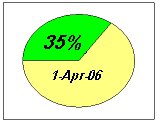Update Katrina Index ...
 As of April 1, we are keeping our March recovery score of 35%. Perhaps some things are improving but, from my perspective, not enough to warrant upping our score.
As of April 1, we are keeping our March recovery score of 35%. Perhaps some things are improving but, from my perspective, not enough to warrant upping our score. So what does 35% recovered mean? I see little effort on much-needed road repairs or getting more traffic lights working. But concern about public safety issues dampens any enthusiasm for how close we are to the "new" normal.
This concern is based on a perceived steep increase in crime statistics, and what seems to be an even greater increase in the cost of protecting our area from natural disasters. We will talk a little about crime next time.
The latest figures on cost of protection add another $6 billion, while assigning these projected costs by parish. We are told that $3 billion can be used to protect 99% of area residents, with the remaining $3 billion needed for Plaquemine parish. If you are living in Plaquemine, begin to make other arrangements.
We close with an excerpt from tomorrow's Louisiana Weekly, New Orleans - A Different Place without the Displaced, by George E. Curry, NNPA Columnist:
"It does not matter how many photos you've seen, how riveting the videotapes have been as they splashed across the television screens, with desperate voices crying out in the background, or listening to the emotional Congressional testimony of displaced residents of New Orleans. None of those experiences - or even all of them combined - can prepare you for the experience of entering the city's lower 9th Ward, where Hurricanes Katrina and Rita roared.
Almost seven months later, it is still hard to believe your eyes. This is the worse of the worst. Debris is piled high in no particular order - on the streets, next to houses, under fallen trees. Whether made of brick or wood, most of the houses are missing windows, doors and people. Roofs can be found where you'd least expect them: on top of overturned automobiles, crumpled under trees, crushed to the ground. There are signs of life slowly returning, but for most part, the residents have not returned. And it's uncertain if they ever will."





0 Comments:
Post a Comment
<< Home